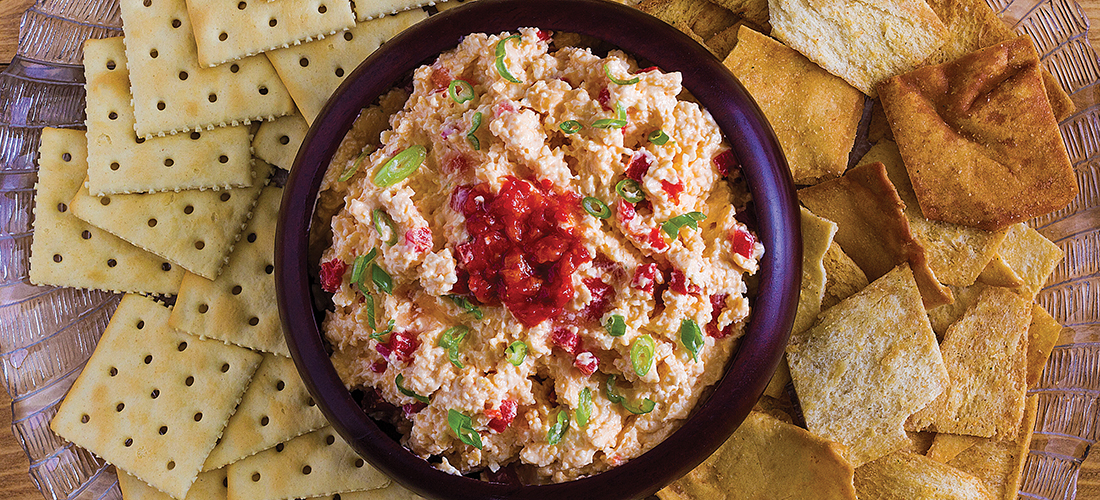
Pimento Cheese, Please
A Southern comfort food for all seasons
By Gayvin Powers
The delicious juxtaposition of sharp, smooth, spicy flavors in pimento cheese have been hitting palates for over 100 years. This gussied-up cheese dish regularly crosses the line between being known as a penny-pincher’s pâté to Southern caviar. Over the last century, it has been regularly spotted at potlucks, Sunday dinners, family gatherings, restaurants, funerals and picnics.
Due to the popularity of pimento cheese in the South, many are surprised to discover that it got its start up North and transformed into a culinary masterpiece in its adopted region.
Pimento cheese is hospitality and culture between two slices of white bread. The South can be hard and beautiful, sweet and strong, traditional and innovative. It makes sense that the South adopted a food that can seamlessly go from tea on the porch to a state dinner. It’s chic, down-home, no fuss, full-bodied and eccentric all in one.
Originally, pimento cheese was created during the processed food movement around the turn of the 20th century, and rumors are that the modern twists on it took root once the South adopted it as its own.
The first step in this delightful culinary favorite began in the 1870s when New York farmers were inspired to create an American version of the French Neufchâtel, a soft, unripened cheese. By the early 1900s, an American Neufchâtel (cream cheese) was on shelves for purchase. Around the same time, Spain started shipping canned pimentos, Spanish peppers, to the United States. The mild, colorful pepper and cream cheese concoction fit the processed food movement and needs of homemakers at the time. It brought “order and scientific precision to all aspects of the home, with a particular emphasis on scientific cooking and a neat dinner table,” according to the website Serious Eats.
The first sighting of pimento cheese is in a 1908 Good Housekeeping article. Lovers of modern pimento cheese recipes will notice key ingredients missing in the first recipe, which called for a cream cheese base without any mention of mild and sharp cheeses or mayonnaise. Early on, newspaper columnists and cookbooks encouraged readers to take the bland mix (cream cheese and pimentos) and experiment with spices and flavors. Early renditions of today’s Southern recipe can be seen in a Shreveport, Louisiana, writer’s recommendation of including “mayonnaise, lemon juice and Tabasco.”
By 1910, pimento cheese was being mass-produced and sold by the slice or in jars from Virginia to Oregon. Georgia farms capitalized on the trend in 1911 by growing pimentos, making the expensive imported delicacies more affordable. Pimento cheese was the blue-collar sandwich that inexpensively fed countless World War I soldiers, and was also the height of sophistication as domestic engineers served it in scooped out cabbages at garden and card parties. Prior to World War II, pimento cheese was found throughout everyday life, regularly featured in newspapers, on menus at the lunch counter and in one’s own icebox. Thanks to its mass appeal, Pomona Products Company of Griffin — a Georgia company and one of the United States’ largest packers — reached a pinnacle year in 1938, producing 10 million cans of pimentos.
As pimento cheese evolved, shredded cheese (sharp and mild) was added as a main ingredient. Sharp cheddar cheese features prominently in modern recipes. This addition meant a binding agent was needed. Cue the mayonnaise. Traditionally, cooks used homemade mayonnaise. Some found that homemade mayonnaise lacked the desired flavors, while others swear by it. If someone is going to use store-bought, Duke’s mayonnaise tends to be the enduring favorite. Due to the playful interpretations of pimento cheese recipes, some cooks won’t touch it without jalapeños, bacon, mustard, cayenne pepper or other ingredients.
Pimento cheese has an uncanny ability to walk in both the high cotton and tidal marshes. The Masters is a perfect example of this quintessential dichotomy. Every April at the Augusta National Golf Club, golf aficionados will spare no expense to attend the Masters and, once inside the gates, purchase a coveted pimento cheese on white bread for a whopping $1.50. Made fresh daily, these sandwiches turn a lowbrow meal into a fashionable tradition at a highbrow event.
While pimento cheese plays a featured role in Augusta, the ruby-speckled creation is a veritable chameleon of culinary versatility: Sometimes it’s a supporting role, and other times it’s the lead. Due to its robust flavor, it’s the star of any plate. In the South, it can be layered into or topped on just about anything from celery, grilled cheese sandwiches, fried green tomatoes, Saltines, Ritz crackers, apples, burgers and more. Others consider pimento cheese a main dish, spooning it straight from the bowl.
One of those people is Pinehurst resident Kristie Sullivan, Ph.D., best-selling author and the head of community at Diet Doctor, who is known for her savory and sweet keto meals that over 275,000 people loyally follow on social media every month. In her fourth keto book, Crazy Busy Keto, coming out in November, Sullivan puts her pimento cheese recipe in the main dish section of the cookbook. Her West Coast editors thought a pimento cheese recipe didn’t belong there.
“Oh, you are not from the South,” she told them, laughing.
Pimento cheese found a home in the South and like many transplants, its arrival enhanced the food, culture and hospitality here. One bite can convert anyone.
Original Recipe — Good Housekeeping, 1908
This recipe calls for a blend of cream cheese, mustard, chives and
minced pimentos.
The Masters Pimento Cheese Recipe
(One Man’s Best Guess)
By Dave Lobeck BBQMyWay writer for News and Tribune and on on YouTube
Over half a century of tradition is wrapped up in the green plastic bags at the Masters at Augusta National. While disturbances over pimento cheese suppliers since 2013 have led longtime patrons, and ESPN, to question the current recipe, Lobeck swears he has cracked the code. By using the ingredients label on the back of the package.
Ingredients
1 cup shredded extra sharp cheddar cheese
1 cup shredded Monterey Jack cheese
8 ounces cream cheese
2/3 cup real mayonnaise
4 ounce can pimentos and juice
2 tablespoons grated onion (or 1 teaspoon onion powder)
1 1/2 teaspoons black pepper
1 1/2 teaspoons granulated garlic
1 teaspoon cayenne pepper
Kristie’s Southern Style Pimento Cheese
By Kristie Sullivan (Keto Friendly)
Many Sandhills residents know Sullivan for her pervious work at Sandhills Community College and her pioneering work worldwide with keto. At 3 years of age, Sullivan began struggling with obesity. After a lifetime of diets, health concerns and ailments, she found a solution in strict ketogenic eating and now works to help others overcome similar struggles.
Pimento cheese is great for a busy lifestyle. Sullivan encourages cooks to play around with ingredients and use what is available in the pantry.
Ingredients
1 cup plus 1 tablespoon mayonnaise
2 ounces cream cheese, softened to room temperature (one carb per serving)
16 ounces shredded cheese (one sharp and one mild — Sullivan uses a blend of Cabot sharp and Kerry Gold)
2 to 3 tablespoons diced pimentos
1 tablespoon Worcestershire sauce
1/4 teaspoon garlic powder
1/4 teaspoon cayenne powder, or more to taste
4 to 5 tablespoons bacon pieces
Mix mayonnaise and cream cheese until well blended. Add mayo mixture to the shredded cheese and mix well. Add pimentos, Worcestershire, garlic powder, cayenne and bacon, and blend well. Refrigerate for an hour or more before eating. Enjoy with a spoon, on celery, or pepperoni chips. This is delicious baked, hot and gooey, and on burgers.
To ensure keto eaters are keeping with keto guidelines, Sullivan recommends the following:
Use Primal Kitchen’s Avocado mayonnaise or Duke’s mayonnaise — Duke’s contains no sugar.
Grate your own cheese. The texture is better when grated at home and is without the starches that coat pre-blended cheeses.
Get creative on your favorite cheeses, one sharp and one mild.
Bacon is a key ingredient in keto cooking. In pimento cheese, it provides protein and salt for flavor. PS
Gayvin Powers is the author of The Adventure of Iona Fay series and a writing coach at Soul Sisters Write. She can be reached at hello@gayvinpowers.com.





